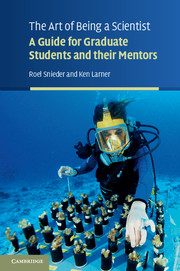Book contents
- Frontmatter
- Contents
- 1 Introduction
- 2 What is science?
- 3 Choices, choices, choices
- 4 The adviser and thesis committee
- 5 Questions drive research
- 6 Giving direction to our work
- 7 Turning challenges into opportunities
- 8 Ethics of research
- 9 Using the scientific literature
- 10 Communication
- 11 Publishing a paper
- 12 Time management
- 13 Writing proposals
- 14 The scientific career
- 15 Applying for a job
- 16 Concluding remarks
- Appendix A Further reading
- Appendix B A sample curriculum
- Appendix C The Refer and BibTeX format
- References
- About the authors
- Index
15 - Applying for a job
Published online by Cambridge University Press: 05 June 2014
- Frontmatter
- Contents
- 1 Introduction
- 2 What is science?
- 3 Choices, choices, choices
- 4 The adviser and thesis committee
- 5 Questions drive research
- 6 Giving direction to our work
- 7 Turning challenges into opportunities
- 8 Ethics of research
- 9 Using the scientific literature
- 10 Communication
- 11 Publishing a paper
- 12 Time management
- 13 Writing proposals
- 14 The scientific career
- 15 Applying for a job
- 16 Concluding remarks
- Appendix A Further reading
- Appendix B A sample curriculum
- Appendix C The Refer and BibTeX format
- References
- About the authors
- Index
Summary
Whatever your current stage in graduate or even undergraduate study, like it or not, sooner or later you will have to work for a living – as if you haven't been working throughout your graduate school career. So, at some point the moment arrives to apply for a job. Much of what is covered in this chapter is the nuts and bolts of the job-application process aimed at a successful outcome of that process – securing a position that is right for you. But, more than just a tutoring of what to do and what not to do in applying for a job, the chapter aims to share our thoughts on subtle matters you might not otherwise think of but can expect to encounter along the way. Much of how to proceed and what to expect in applying for a job is common to careers in both academia and industry, but we shall also highlight differences.
As indicated in Chapter 14, the first job in an academic environment is likely to be a temporary position as a postdoc. Even then, soon enough the task of applying for a job will appear on the horizon, this time perhaps for a tenure-track faculty position. In industry, life-long employment with a single company used to be common, but this has changed considerably in the ever-more-dynamic world of today.
- Type
- Chapter
- Information
- The Art of Being a ScientistA Guide for Graduate Students and their Mentors, pp. 233 - 252Publisher: Cambridge University PressPrint publication year: 2009

